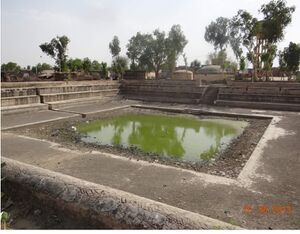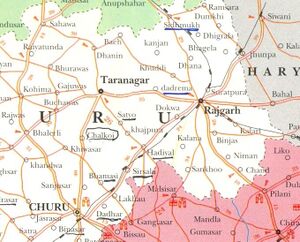Sidhmukh
Sidhmukh (सिद्धमुख) is a town of historical importance located in Churu district of Rajasthan, India. It is situated in Rajgarh tehsil in Churu district.
Contents
चाहर राज्य
संवत 1324 विक्रम (1268 ई.) में कंवरराम चाहर व कानजी चाहर ने बादशाह बलवान को पांच हजार चांदी के सिक्के एवं घोड़ी नजराने में दी। बादशाह बलवान ने खुश होकर कांजण (बीकानेर के पास) का राज्य दिया। 1266 -1287 ई तक गयासुदीन बलवान ने राज्य किया। सिद्धमुख एवं कांजण दोनों जांगल प्रदेश में चाहर राज्य थे।
राजा मालदेव चाहर - जांगल प्रदेश के सात पट्टीदार लम्बरदारों (80 गाँवों की एक पट्टी होती थी) से पूरा लगान न उगा पाने के कारण दिल्ली का बादशाह खिज्रखां मुबारिक (सैयद वंश) नाराज हो गए। उसने उन सातों चौधरियों को पकड़ने के लिए सेनापति बाजखां पठान के नेतृतव में सेना भेजी। खिज्रखां सैयद का शासन 1414 ई से 1421 ई तक था। बाजखां पठान इन सात चौधरियों को गिरफ्तार कर दिल्ली लेजा रहा था। यह लश्कर कांजण से गुजरा। अपनी रानी के कहने पर राजा मालदेव ने सेनापति बाजखां पठान को इन चौधरियों को छोड़ने के लिए कहा. किन्तु वह नहीं माना। आखिर में युद्ध हुआ जिसमें मुग़ल सेना मारी गयी. इस घटना से यह कहावत प्रचलित है कि -
- माला तुर्क पछाड़याँ दे दोख्याँ सर दोट ।
- सात जात (गोत) के चौधरी, बसे चाहर की ओट ।
ये सात चौधरी सऊ, सहारण, गोदारा, बेनीवाल, पूनिया, सिहाग और कस्वां गोत्र के थे।
विक्रम संवत 1473 (1416 ई.) में स्वयं बादशाह खिज्रखां मुबारिक सैयद एक विशाल सेना लेकर राजा माल देव चाहर को सबक सिखाने आया। एक तरफ सिधमुख एवं कांजण की छोटी सेना थी तो दूसरी तरफ दिल्ली बादशाह की विशाल सेना।
मालदेव चाहर की अत्यंत रूपवती कन्या सोमादेवी थी। कहते हैं कि आपस में लड़ते सांडों को वह सींगों से पकड़कर अलग कर देती थी। बादशाह ने संधि प्रस्ताव के रूप में युद्ध का हर्जाना और विजय के प्रतीक रूप में सोमादेवी का डोला माँगा। स्वाभिमानी मालदेव ने धर्म-पथ पर बलिदान होना श्रेयष्कर समझा। चाहरों एवं खिजरखां सैयद में युद्ध हुआ। इस युद्ध में सोमादेवी भी पुरुष वेश में लड़ी। युद्ध में दोनों पिता-पुत्री एवं अधिकांश चाहर मारे गए।[1]
कस्वां पट्टी
चूरू जनपद के जाट इतिहास पर दौलतराम सारण डालमाण[2] ने अनुसन्धान किया है और लिखा है कि पाउलेट तथा अन्य लेखकों ने इस हाकडा नदी के बेल्ट में निम्नानुसार जाटों के जनपदीय शासन का उल्लेख किया है जो बीकानेर रियासत की स्थापना के समय था।
| क्र.सं. | जनपद | क्षेत्रफल | राजधानी | मुखिया | प्रमुख ठिकाने |
|---|---|---|---|---|---|
| 6. | कस्वां पट्टी | 360 गाँव | सिद्धमुख | कंवरपाल कस्वां | सात्यूं ,लालासर |
कसवां जाटों के भाटों तथा उनके पुरोहित दाहिमा ब्रह्मण की बही से ज्ञात होता है की कंसुपाल पड़िहार संघ में सम्मिलित था। वह 5000 फौज के साथ मंडोर छोड़कर पहले तालछापर पर आए, जहाँ मोहिलों का राज था. कंसुपाल ने मोहिलों को हराकर छापर पर अधिकार कर लिया. इसके बाद वह आसोज बदी 4 संवत 1125 मंगलवार (19 अगस्त 1068) को सीधमुख आया. वहां रणजीत जोहिया राज करता था जिसके अधिकार में 125 गाँव थे. लड़ाई हुई जिसमें 125 जोहिया तथा कंसुपाल के 70 लोग मारे गए. इस लड़ाई में कंसुपाल विजयी हुए. सीधमुख पर कंसुपाल का अधिकार हो गया और वहां पर भी अपने थाने स्थापित किए. सीधमुख विजय के बाद कंसुपाल सात्यूं (चुरू से 12 कोस उत्तर-पूर्व) आया, जहाँ चौहानों के सात भाई (सातू, सूरजमल, भोमानी, नरसी, तेजसी, कीरतसी और प्रतापसी) राज करते थे. कंसुपाल ने यहाँ उनसे लड़ाई की जिसमें सातों चौहान भाई मरे गए. चौहान भाइयों की सात स्त्रियाँ- भाटियाणी, नौरंगदे, पंवार तथा हीरू आदि सती हुई. कंसुपाल की संतान कसवां कहलाई. फाल्गुन सुदी 2 शनिवार, संवत 1150, 18 फरवरी, 1094, के दिन कंसुपाल का सात्यूं पर कब्जा हो गया. फ़िर सात्यूं से कसवां लोग समय-समय पर आस-पास के भिन्न-भिन्न स्थानों पर फ़ैल गए और उनके अपने-अपने ठिकाने स्थापित किए. [3] [4]
भाखर गोत्र के इतिहास में
भाखर गोत्र के प्रमुख निकास स्थल व थान[5]:
गढ़ आबू (निकास वि.सं 1260= 1203 ई.) → सांभर निकास → अजमेर निकास → सिद्धमुख निकास → ददरेवा निकास → तीबो डोडो थान (?) → भाखरोली थान → लाडनू थान → बलदु थान → कीचक थान → फोगड़ी थान → खाखोली थान → मोडावट थान → फागल्वा थान → रुल्याणा थान → बरड़वा थान → रातगो थान → आजड़ोली थान → डकावा थान → सुनथली थान (?) → घस्सू थान → थोरासी थान
भाखर गोत्र के बसने और विस्थापन का क्रम[6]:
गढ़ आबू (वि.सं 1260= 1203 ई.) → सांभर → भाखरोली (वि.सं 1263= 1206 ई.) → ददरेवा (वि.सं 1360= 1303 ई.) → बलदु (वि.सं 1420= 1363 ई.) → कीचक (वि.सं 1499= 1442 ई.) → मोडावट (वि.सं 1512= 1455 ई.) → फागल्वा (वि.सं 1670= 1613 ई.) → सिगड़ोला छोटा (वि.सं 1954= 1897 ई.) → रुल्याणा माली (वि.सं 1956= 1899 ई.)
Population
According to 2001 census, the population of village was 7242, out of them 1404 were SC and 52 were ST people.
- As per Census-2011 statistics, Sidhmukh village has the total population of 7767 (of which 4056 are males while 3711 are females).[7]
Jat Gotras
Chahar rule
Raja Maldeo was a ruler in the thirteenth century, a Chahar Jat, who ruled at Sidhmukh in Jangladesh (Bikaner). Ghulam Badshah was the then Muslim ruler of Delhi. Ghulam's army while returning from Jaisalmer clashed with Raja Maldeo. It happened like this.
Two bulls were fighting. The Delhi army was watching it, but no one dared to stop them. It was then that Raja Maldeo’s daughter, Somadevi, came out and caught both the bulls by the horns and quietened them.
The Muslim ruler was so impressed that he asked for Somadevi’s hand in marriage. But Raja Maldeo refused the offer. The ruler then tried to take away Somadevi forcefully.
This led to a bloody battle in which Raja Maldeo, Somadevi and many Jats died. The location of the battle is said to be near the border of Sidhmukh. The remaining members of Raja Maldeo's family migrated to the Jhunjhawati region (present-day Jhunjhunu).[8]
Kaswan rule
It was the capital of Kaswan Jat rulers of Jangladesh. When Rathores under the leadership of Bika were spreading their rule in Jangladesh in late fifteenth century, At that time Kaswan Jats were ruling in about 400 villages in Jangladesh. Kanwarpal was their king and their capital was at Sidhmukh town. The Kaswan people were known as warriors who used to fight with patience. They had 2000 camel and 500 riders always ready for defence. They were good cultivators as well as super soldiers.
Punia rule
According to James Tod as mentioned in his book "Annals and Antiquities of Rajasthan (1829)" the Jangladesh region was inhabited by Jats or Jits, who had for ages been established in these arid abodes. At every stage of invasion to India the invaders had to encounter with the Jats of this region. At what period the Jats established themselves in the Indian desert is not known. By the 4th century they had spread upto Punjab in India.
Nearly the whole of the territory forming the boundaries of Bikaner was possessed by the six Jat cantons namely:—
1. Poonia, 2, Godara, 3. Saran 4. Asiagh 5. Beniwal 6. Johiya, or Joweya
Each canton bore the name of the community, and was subdivided into districts. Number of villages in each canton and Districts included in them were as under :
Poonia : Villages - 300 Districts : Bhadra, Ajitpura, Sidhmukh, Rajgarh, Dadrewa, Sankhoo, etc. [9]
Chauhan rulers
H.A. Rose[10] writes that In Hissar the true Chauhans are immigrants and may be divided into two branches, the Nimrana* and Sidhmukh or, as they call themselves, Bārā Thāl. The Nimranas who are descendants of Raja Sangāt, a great-grandson of Chahir Deo, brother of Pirthi Raj, are sub-divided into two clans, Rāth and Bāgauta, both of which came from Gurgaon, the former tracing their origin to Jātsāna. The name Bagauta would appear to be connected with Bighota.†
The Bārā Thāl had a group of 12 villages near Sidhmukh in Bikaner, close to a famous shrine of Guga.
The Sohu and Chotia Pachadas claim Chauhan descent.
Notable persons
- Atar Singh Mahla, Village Sidhmukh, District Churu, Ex.Saudh & Sanskriti Mantri Jat Kirti Sansthan Churu, Mob:9784635530
- Suman Sihag - From Dhani Badi, Sidhmukh, got Gold Medal for Long Jump in State Open Championship.[11]
- Likhma Ram Kalirawana, Sidhmukh, Worker of Rajgarh Kisan Sabha[13]
External links
- Information about Sidhmukh village - villageinfo.in website
- Delimitation Commission Report
- Villages in the Rajgarh tehsil, Churu district, Rajasthan
See also
Further reading
- Dr Mahendra Singh Arya, Dharmpal Singh Dudi, Kishan Singh Faujdar & Vijendra Singh Narwar: Ādhunik Jat Itihasa (The modern history of Jats), Agra 1998
- Thakur Deshraj: Jat Itihasa (Hindi), Maharaja Suraj Mal Smarak Shiksha Sansthan, Delhi, 1934, 2nd edition 1992.
References
- ↑ अनूप सिंह चाहर, जाट समाज आगरा, नवम्बर 2013, पृ. 28-27
- ↑ 'धरती पुत्र : जाट बौधिक एवं प्रतिभा सम्मान समारोह, साहवा, स्मारिका दिनांक 30 दिसंबर 2012', पेज 8-10
- ↑ गोविन्द अग्रवाल, चुरू मंडल का शोधपूर्ण इतिहास, पेज 115-116
- ↑ Dr Pema Ram, The Jats Vol. 3, ed. Dr Vir Singh,Originals, Delhi, 2007 p. 203-204
- ↑ Raghunath Bhakhar: 'Rulyana Mali' (Jhankata Ateet), Bhaskar Prakashan Sikar, 2022. ISBN: 978-93-5607-079-0, p.322
- ↑ Raghunath Bhakhar: 'Rulyana Mali' (Jhankata Ateet), Bhaskar Prakashan Sikar, 2022. ISBN: 978-93-5607-079-0, p.323
- ↑ http://www.census2011.co.in/data/village/70066-sidhmukh-rajasthan.html
- ↑ Jat History Thakur Deshraj/Chapter IX,p.603
- ↑ James Tod: "Annals and Antiquities of Rajasthan (1829)"
- ↑ A glossary of the Tribes and Castes of the Punjab and North-West Frontier Province By H.A. Rose Vol II/B , p.156
- ↑ Jat Gatha, 7/2016, p.20
- ↑ Ganesh Berwal: 'Jan Jagaran Ke Jan Nayak Kamred Mohar Singh', 2016, ISBN 978.81.926510.7.1, p.168
- ↑ Ganesh Berwal: 'Jan Jagaran Ke Jan Nayak Kamred Mohar Singh', 2016, ISBN 978.81.926510.7.1, p.168
back to Jat Villages

